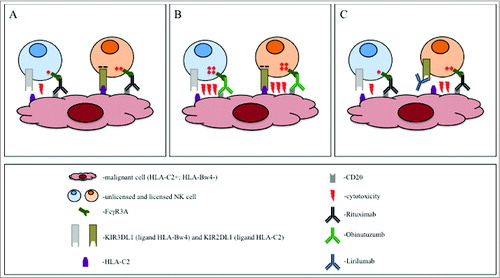Figures & data
Figure 1. Strategies to induce NK-cell-driven antibody dependent cell cytotoxicity (ADCC) against lymphoma. CD20+ malignant B cells in an HLA-C2+, Bw4− individual are treated with anti-CD20-antibodies. The presence of the HLA-C2 and the lack of HLA-Bw4 defines the KIR2DL1+ natural killer (NK) cell as licensed and KIR3DL1+ as unlicensed, respectively. (A) The rituximab-induced activating signal is inhibited by the KIR2DL1/HLA-C2 interaction in the licensed NK cell. The activation in the KIR3DL1+ NK cell cannot be inhibited because of the lack of the HLA-Bw4 on the malignant cell. However, its activity is compromised by its unlicensed status. (B) The stronger activation induced by obinutuzumab overrides the inhibitory signal in the licensed KIR2DL1+ cell. In addition, the activation is superior to the unlicensed status of the KIR3DL1+ cell. (C) Due to the block of the KIR2DL1/HLA-C2 interaction by lirilumab, the licensed KIR2DL1+ cell can be activated with rituximab. Lirilumab does not react with the KIR3DL1. Therefore, the activity of the unlicensed KIR3DL1+ cell is not influenced.

